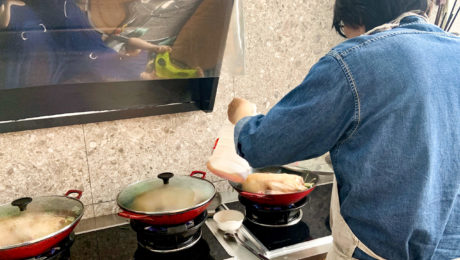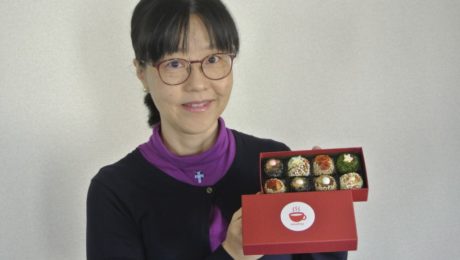The Trending Nordic Diet
For nearly two decades, the Mediterranean diet has been the food choice recommended by dietitians and the USDA.. This approach to eating has been proven to improve health and reduce risk of chronic disease.
But there’s a new contender: the Nordic diet.
This plan focuses on eating fermented foods and beverages, with less meat and more legumes than in the Mediterranean diet. Both approaches are plant-based and full of lean proteins, complex carbs and healthy fats.
“The nordic diet really does promote a lifelong approach to healthy eating,” says Valerie Agyeman, RDN (pictured). “It also really really focuses on seasonal, local, organic and sustainably sourced whole foods that are traditionally eaten in the Nordic region.”
Agyeman, founder of Flourish Heights, shared her research during a Today’s Dietitian webinar “Breaking Down the Nordic Diet: Why is it Gaining So Much Popularity?” The presentation was designed to help registered dietitians better counsel clients on healthy eating habits.
What is Nordic Eating?
The diet embraces traditional Nordic cuisine, with a focus on ingredients that are fresh and local. The core of the fare is from Sweden, Norway, Denmark, Finland and Iceland.
“Fresh, pure and earthly are the words used to describe this food movement that was born out of the landscape and culture,” Agyeman says. “The Nordic movement is all about using what is available.”
The goal is not to invent a new cuisine, but to get back to its roots. Seafood is central, but meat – scarce during the long Nordic winters – is treated as a side dish Fresh vegetables and berries – the most common Nordic fruit – are prevalent during the summer. Fermented foods were born out of the necessity to preserve food from the warmer months to eat during winter. The indigenous Nordic people traditionally fermented vegetables, fish and dairy.
“It really takes the focus off calories and puts it on healthy food,” Agyeman adds. “This way of eating is pretty nutrient-dense.”
Nordic foods, she continues, are served in their natural state with minimal processing. They’re high in antioxidants, prebiotics, probiotics, fiber, minerals and vitamins; low in saturated fats, trans fats, added sugars and added salts.
“The Nordic diet is really not that straightforward,” Agyeman says. “When you think of other cuisines, like Italian cuisine, they have signature flavors and various culinary techniques that make up Italian cuisine. When it comes to Nordic cooking, it’s very diverse.”
Sustainability
Key, too, is sustainability. Foods from the Nordic countries have a lower environmental impact because they’re sourced locally and eaten in season.
Sustainability is also partly why Nordic cuisine has become a staple at many restaurants. The farm-to-table style continues to expand in restaurant dining, along with fermentation. Restaurants around the world are following the lead of Copenhagen’s Noma and building their own labs to explore the flavors and textures fermentation adds to dishes.
“Today [fermentation] is not something that’s needed,” like it was before a global food scene made it simpler to eat fresh food year round, Agyeman says. “But culinary wise, fermentation has evolved. It’s become a big part of these new creations.”
Fermented foods and beverages add to the “epicurean experience,” adds Dr. Luiza Petre, a cardiologist and nutrition expert based in New York.
“Savory flavors and fermented food with spices make it a culinary experience,” she says.
Health Benefits
Studies show eating the Nordic diet prevents obesity and reduces the risk of cardiovascular disease, type 2 diabetes, high blood pressure and high cholesterol.
The health effects of the Nordic diet were always assumed to be solely due to weight loss. But results of the most recent study of the diet, published in the journal Clinical Nutrition in February, found the positive health effects are “irrespective of weight loss.”
“It’s surprising because most people believe that positive effects on blood sugar and cholesterol are solely due to weight loss. Here, we have found this not to be the case. Other mechanisms are also at play,” said Lars Ove Dragsted, of the University of Copenhagen’s Department of Nutrition, Exercise and Sports in a statement on the study.
The researchers from Denmark, Finland, Norway, Sweden and Iceland studied 200 people over 50 years of age with elevated BMI. All were at an increased risk of diabetes and cardiovascular disease. For six months, the group ate the Nordic diet while a control group ate their regular meals.
“The group that had been on the Nordic diet for six months became significantly healthier, with lower cholesterol levels, lower overall levels of both saturated and unsaturated fat in the blood, and better regulation of glucose, compared to the control group,” Dragsted said. “We kept the group on the Nordic diet weight stable, meaning that we asked them to eat more if they lost weight. Even without weight loss, we could see an improvement in their health.”
- Published in Health
China’s Secret Sauce
NPR highlights “Lu, the secret sauce at the heart of many Chinese family cuisines.” Every Chinese region uses a variation of Lu in their cuisine. It is made from a base of salty liquid (like soy sauce) mixed with sugar and spices. But salt is core to the product, more so than the spices.
Lu takes on “the characteristics of each of China’s regional cuisines.” In Sichuan, Lu is spicy; in Zao, it is alcoholic, made from the fermented rice left over from brewing Chinese yellow wine.
One Chinese restaurant chef (pictured, who asked NPR to keep him anonymous so his restaurant stays out of the limelight) traces his Lu sauce to “an unbroken chain of sauces dating back to that first batch his mother made in the 1980s.” The chef takes his sauce at the end of each day and gives it “nutrients” – fresh spices and meat boiled in Lu.
“It is a bit like sourdough, where the last batch seeds the next batch, and the flavor intensifies over the years,” the piece continues.
Read more (NPR)
- Published in Food & Flavor
Jewish Delis GoVegan
Jewish delis are evolving for modern consumers, offering plant-based alternatives to lox and pastrami.
“We’re literally saving the Jewish deli. We’re giving it the modern twist that’s desperately needed to stay delicious and relevant to a growing segment of the population,” said Jenny Goldfarb, the founder and CEO of Unreal Deli. Goldfarb’s plant-based corned-beef-pastrami hybrid attracted an investment deal on SharkTank, and today it’s available in 2,200 grocery stores.
Though Jewish cuisine is known for being heavy on meat, vegetarian food has a part in Ashkenazi culture, notes Jeremy Umansky, chef at Larder Deli in Cleveland. He points out that kashruth (kosher dietary laws) and periods of poverty meant Jewish cuisine always included vegetarian recipes.
The food at Larder — which includes vegan and vegetarian dishes — is put through the same process as animal-based items. Umansky cures mushrooms with salt and koji for a smoky, savory flavor and meat-like texture.
“It’s all about the method and technique behind the production of those foods,” Umansky said. “You know, going back and looking at things and seeing that there is historical precedent for this.” Pictured, a selection of vegan Jewish deli fare at Ben & Esther’s in Portland, Oregon.
Read more (Insider)
- Published in Business, Food & Flavor
Expo West Returns
In March 2020, Natural Products Expo West became one of the first casualties in the U.S. events world, shut down by the outbreak of Covid-19 even as booths were being set up in Anaheim. Now, two years later, Expo West returns to Orange County with natural food exhibitors from around the world. TFA staff and advisory board members will also be in attendance.
In 2019, the enormous spring trade show attracted around 88,000 registrations; this year, that number is estimated at 55,000-60,000. Show producer New Hope Network (part of London-based Informa PLC) is also including a virtual option for attendees still unable or unwilling to travel.
The trends at this year’s event are being driven by Millennial and Gen Z consumers. New Hope put a spotlight on six top themes in a recent webinar:
No. 1: Functional Ingredients. “Health and wellness products make up a quarter of the volume of the industry but represent two-thirds of all growth,” said SPINS Data Analyst Scott Dicker. “We’re seeing consumers pushing for individual pursuit of wellness across channels.”
No. 2: Organic & Regenerative. Food that focuses on performance nutrition, food made with ashwagandha or food with paleo ingredients are driving growth for organic and regenerative products. Sodas and carbonated beverages are also helping organic products grow, “one of the last ‘junk food’ categories penetrated by natural and organic,” Dicker said. Gut health sodas, especially.
No. 3: Climate and Sustainability. Media headlines are declaring carbon as the new calorie. Consumer surveys speak to that — 70% will pay more for “premium, sustainable, climate-friendly products” and 80% want brands to educate them on their roles in climate issues. Companies are changing ingredient sources and product packaging to be more environmentally-friendly.
No. 4: Diversity. “Over the past couple years, we’ve seen tremendous growth in women, minority, NGLCC (National LGBT Chamber of Commerce) certified and veteran-owned businesses and you’re going to see it all over the show floor,” Dicker said.
No. 5: Plant-Based Innovation. Plant-based eating has skyrocketed over the last five years. “But plant-based alone isn’t enough anymore. What are plant-based brands doing to keep up with innovation?” Dicker said.
No. 6: Sustainable Meat & Dairy. Though the sustainable meat and dairy category is down 2.1%, pockets of it are growing, specifically grass-fed, fair trade and animal welfare and sustainability claims. Innovations are coming from small and local farms.
Read more (New Hope Network)
- Published in Business, Food & Flavor
Asian American Entrepreneurs React to Online Trolls
Racist and sexist comments have long been hurled at food companies run by Asian American women. But in the modern tech era, where food brands have a social media presence, these cruel remarks from trolls are being dealt with in a variety of ways. Some fight back with humor, others aim to educate while some ignore it.
Kim Pham, co-founder (with her sister Vanessa) of Omsom (which sells Asian pantry staples), said it was difficult in the brand’s early days for her to read offensive comments. She came to a sad realization: “I think it’s par for the course when you are an outspoken brand run by women of color.”
“For so long our community has been defined by this model minority myth, of being quiet, or docile, or submissive,” said Pham, “and we really just wanted to give a middle finger to that.”
Omsom’s social media policy is to remove insulting comments, but leave anything that “might generate a fruitful conversation.”
Jing Gao of Fly By Jing (which sells Asian pantry staples, dumplings and hot pots) (pictured), though, takes a different approach. “We have no problem making fun of those people who are, you know, clearly disturbed,” said Jing Gao, the company’s 34-year-old founder, adding “We definitely troll them. … and our community seems to really love it.”
Meanwhile Sahra Nguyen, founder of Nguyen Coffee Supply, has zero tolerance for trolls. She doesn’t want her employees engaging in toxic behavior, so they don’t respond.
Read more (The New York Times)
- Published in Business
Is Fermentation “So White”…or Not?
More international fermented foods and beverages are entering the American food scene, an exciting development in an expanding market. But the origins of many of these traditional dishes get blurred by western producers.
In a panel on diversity and cultural appropriation during TFA’s conference FERMENTATION 2021, BIPOC food professionals encouraged fermenters to innovate with food from different countries, but to be mindful of their approach. A dish’s culture must be respected, its history acknowledged and negative stereotypes eliminated. The talk “Is Fermentation ‘So White’…or Not?” included panelists Miin Chan (educator and writer working on her PhD), Jiayang Fan (staff writer for The New Yorker), Mara Jane King (director of fermentation for IE Hospitality), Kheedim Oh (founder of Mama O’s Premium Kimchi, and TFA Advisory Board member) and Sebastian Vargo (founder of Vargo Brother Ferments).
Last year, two articles helped propel a conversation on diversity among fermenters. One was Fan’s New Yorker article “The Gatekeepers Who Get to Decide What Food is Disgusting,” which highlights how a western view of “disgusting” food requires immigrants to assimilate to local food cultures. Another was Chan’s Eater article “Lost in the Brine,” which explores cultural appropriation in fermentation.
Oh expressed his frustration watching companies produce kimchi without any cultural ties to or acknowledgement of its Korean history. Vargo agreed.
“Whether it is financial or just overall exposure, you really can’t deny the fact that oftentimes…a white face or a white person borrowing off the culture will oftentimes achieve higher amounts of success,” Vargo says. Kimchi has exploded in popularity in the U.S. the past few years – and some white producers receive more funding than traditional Korean companies. “They’re overshadowing the people that actually deserve to have their stories told in the first place.”
Traditional ferments can get watered down, tailored to follow food trends instead of staying true to their historical roots. Chan pointed out that, in Australia, there’s no regulation around labeling certain foods. Pickled cucumbers could be labeled as kimchi, appealing to western consumer tastes.
“Whether it’s in fermentation or the food industry or just any industry that we exist in within this capitalist system, there’s systemic racism and there’s some historical forces that mean that BIPOC basically often have less access to social and financial capital,” she adds.
Cookbook author Alison Roman came under fire when she released a curry recipe she labeled as a stew. There was no history detailing curry’s Southeastern Asian roots and no context of where the recipe idea originated.
“She literally whitewashed all of the culture out of it and made it into something that she could sell,” King said. “Labeling something to suit you and to suit your benefit and your profit can be harmful to people of color.”
It’s a problem in restaurant reviews too, Fan pointed out. Food critics tend to draw a western comparison to more exotic cuisines, comparing an Asian rice dish to a pasta, for example, offering their own translation. She recently wrote a review on a hot pot restaurant in New York and felt compelled to compare it to fondue. She had a limited word count and wanted to be succinct. But a coworker asked: Why not just explain what it is?
“In the process of being a writer, a critic, (I need) to introduce those words in the cultural lexicon so that the western standard isnt kind of the defacto comparison for everything,” she said.
Who decides French cuisine is more elevated than Chinese, Oh questions.
“I think that’s the huge problem is that there’s so much inherent cultural bias that even we as minorities too will have within ourselves that keeps getting perpetuated,” Oh says, noting people of color are not pigeonholed to only cooking their traditional food, too.
Society needs to value traditional cooking arts so food history and knowledge – especially from more rural parts of the world – isn’t lost, Chan adds.
“I think we’ve come around now, the work that (the panelists) and many other fermenters do shows we want to be connected to our traditional food system, we don’t want to lose these tastes and we want to understand our microbial heritages,” she says.
- Published in Business, Food & Flavor
World’s Rarest Foods in Danger of Extinction
Journalist Dan Saladino explores the world’s endangered foods in his new book Eating to Extinction: The World’s Rarest Foods and Why We Need to Save Them. He argues that the world could lose culinary diversity. “The story of these foods, and the way in which they’re presented in the book,” says Saladino, from wild foods associated with hunters and gathers, to cereals, vegetables, meats and more, “is really the story of us and our own evolution.”
A review of Saladino’s book in Smithsonian Magazine shares 10 of the world’s rarest foods — five of them fermented. These rarities include:
- Skerpikjøt (Faroe Islands, Denmark): Dried and fermented mutton made from the shanks and legs of sheep. It ferments in wooden sheds called hjallur, which have vertical slats that allow space for the salty sea wind to blow in.
- Salers cheese (Auvergne, France): One of the world’s oldest raw milk cheeses made from the milk of Salers cows. The semi-hard cheese is made with varying fermentation lengths, which change the flavor.
- Qvevri wine (Georgia): Winemakers fill the egg-shaped terracotta pots called qvevri with grape juice, skins and stalks, then bury the pots underground. The steady temperatures and the pot’s shape allows even fermentation.
- Ancient Forest Pu-Erh Tea (Xishuangbanna, China): The fermented tea is made from wild tea leaves that grow in China’s southwestern Yunnan province. The leaves are sun-dried, cooked, kneaded, then formed into solid cakes and fermented for months (or years).
- Criollo Cacao (Cumanacoa, Venezuela): The world’s rarest type of cacao, it represents less than 5% of the cocoa production on the planet. The bean lacks bitterness, but is difficult to grow.
Read more (Smithsonian Magazine)
- Published in Food & Flavor
Preserving Japan’s Miso Culture
A Japanese public-relations-exec-turned-chef has developed a unique product — Miso Drops, individually-sized servings of stock. She felt it was difficult for an individual customer to use miso from traditional breweries because they only ship products weighing at least 500 grams. Her drops weigh around 26 grams.
Entrepreneur Motomi Takahashi, “alarmed by the gradual disappearance of small-scale miso breweries that have been a key part of Japan’s tradition of fermented foods,” created the soybean paste balls using traditional methods. And, different from the large factories that mass-produce miso products, Takahashi’s miso drops are handmade.
Important to Takahashi is preserving Japan’s rich miso culture. Small-scale miso brewing in the country is “in danger of extinction,” notes an article in Kyodo News. In Japan’s Nagano Prefecture, where most of the miso in the country is made, the number of miso breweries declined 42% from 1963-2010.
Takahashi is developing a product line called misodrop47, which will feature miso drops made in each of Japan’s 47 prefectures. Currently, hermiso drops come from eight.” I wanted to develop products for the misodrop47 project to allow customers to casually sample miso from all over Japan,” she says.
Read more (Kyodo News)
- Published in Business, Food & Flavor








